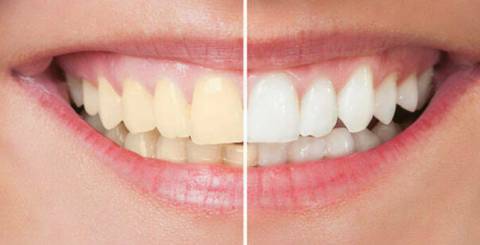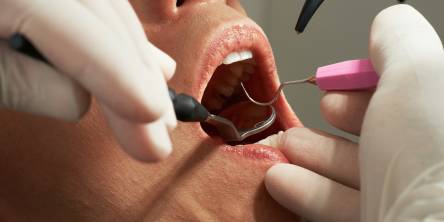Efficient Types and Methods of Teeth Whitening

A wide, sincere smile is essential in our daily lives. It is usually easier to interact with kind, smiling folks. We get the impression that they are open to discussion and pleasant toward us. Today, a wide white smile also represents success and happiness.
What if you don't have naturally white teeth? There is no need to despair because cosmetic dentistry provides plenty of solutions to this problem. Here are a few examples:
Teeth whitening: types and methods
Mechanical method
The most basic and long-used procedure for whitening tooth enamel in dentistry is a mechanical cleaning method with specialized attachments. This approach removes plaque and fossilized deposits from teeth and prevents cavities and gum disease. Following the operation, the dentist coats the teeth with a substance to protect the enamel.
Photobleaching
This approach allows for color changes of up to 8 - 10 tones. The dentist applies a whitening gel containing hydrogen peroxide during the procedure and activates it using appropriate radiation. Halogen, UV, and LED (LED lamp irradiation) can all be employed. One operation takes 15 to 30 minutes. Following photobleaching, a fluoride compound is administered to the teeth to minimize sensitivity and protect enamel.
Chemical bleaching
This is one of the gentler procedures, so your teeth will only lighten by 5 to 7 shades. If you're unsure how to whiten your teeth, start with this. The whitening gel is applied uniformly across the enamel. If you do this with a professional, they will use a composition with a high bleaching agent concentration. A rubber plate will protect your gums and sensitive tissues from harm during the procedure. In this situation, neither a laser nor ultraviolet light are used. Chemical bonding is not recommended if the patient has polymer fillings, crowns, or veneers.
In-ear whitening
It is also known as endobleaching. If the tooth is badly darkened, this approach may be used following treatment and root canal filling. The doctor prepares the tooth, inserts a specific substance, and fills it. When the desired result is obtained, the tooth is repaired. This method of whitening can only be performed once.
Laser whitening
If you want to whiten your teeth, only your doctor can tell you which approach is ideal. They will offer the best option for your situation. We may say that laser teeth whitening is currently the safest and most popular way. Its effect is long-lasting. As a result, this method is quite helpful despite its higher cost compared to other procedures.
How can you whiten your teeth at home?
There are many ways to whiten your teeth at home if you want it:
Whitening pencil
This is an excellent method for fast whitening your teeth on the go. The pencil's convenient release method and efficient substance make it simple and invisible to others to apply the whitening solution to the tooth enamel while sitting at a cafe table at work. This device is helpful for those who enjoy coffee and strong tea. The brightening agent's components, which restore a light color to the enamel in about 10 minutes, sustain and extend the effects of therapeutic bonding procedures.
Kappa system
For home use, you can use a custom-made gel with a tray, which is available in dentistry. A simpler pair with a normal mouthguard can be acquired from the pharmacy. With a modest proportion of carbamide or hydrogen peroxide in the gel's composition, teeth can be lightened by 5 to 8 tones.
Stripes
They have a modest concentration of hydrogen peroxide gel. To achieve the best results, the strips must be adhered to the teeth and preserved for the time stated in the instructions. This will brighten the enamel by approximately 3 to 5 tones.
Similar Articles
The desire for a healthy smile drives approximately 4 million people toward teeth straightening procedures. When it comes to straightening teeth, lingual braces offer a discreet alternative to traditional braces and clear aligners.
As we grow older, our dental needs evolve significantly. The carefree days of childhood tooth fairy visits transform into the more complex world of adult dental care. After age 25, many adults begin to notice changes in their oral health.
Missing teeth can cause a wide range of oral health issues. Nonetheless, over 120 million Americans are missing at least one tooth, and the figure is anticipated to climb as time passes.
A dental emergency doesn’t make an appointment. It shows up unannounced and unapologetic, usually in the middle of the night or during a meal that was supposed to be fun
A dental emergency can strike fast and without warning—during dinner, in the middle of the night, or just before a big meeting.
A wide range of factors can have a direct effect on your oral health. A balanced diet is essential, as is good oral hygiene and regular dental examinations. Many individuals think that nutrition alone can't improve oral health.
The results of wearing Invisalign aligners look stunning, and they are way more convenient than traditional braces. However, no one speaks about what it feels like to wear the same pair of traces around 22 hours a day
Temporomandibular Joint Disorder, commonly known as TMJ, is a condition that causes pain and dysfunction in the jaw joint and surrounding muscles. This disorder can arise from various factors, including teeth grinding, arthritis, jaw injuries, poor posture, or stress.
A root canal is a common treatment that people pay the dentist a visit for. According to a study, root canal treatment claims were up by 42% in the last five years.









